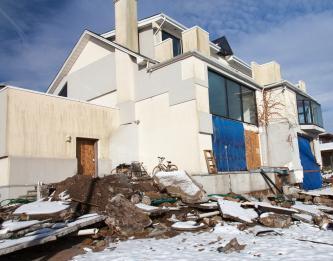 As survivors of Hurricane Sandy wait for the adjuster to show up, there are steps they can take to get their homes ready and make the most of the adjuster’s visit.
As survivors of Hurricane Sandy wait for the adjuster to show up, there are steps they can take to get their homes ready and make the most of the adjuster’s visit.
It’s a key part of getting a damaged property repaired or replaced as soon as possible, according to the Insurance Information Institute.
After reporting a claim, the insurance company will either send a proof of loss form, for the homeowner to fill out, or schedule an appointment to have an insurance adjuster inspect the site and guide the homeowner through the claims process.
Adjusters are professionally trained and licensed to assess damage and different types of claims may require the specialized knowledge of various claims adjusters, so there could be more than one adjuster assigned.
For example, there could be a claims professional to assess structural damage, a contents specialist to help with the loss of personal property and a separate adjuster to inspect damage to the car.
Additionally, for homes with a flood insurance policy or separate coverage for wind damage through a state-run insurance pool, there could be a different claims adjuster assigned.
As part of the claims process, the adjuster (or adjusters) will review all information and the insurance policy to determine coverage and ask the homeowner to obtain estimates for repairs. The more information about the damage you can supply, the faster your claim can be settled.
These six important steps will help homeowners prepare for the claims process:
1. Contact the insurer as soon as possible. Make sure the insurance company knows how to reach you if you have evacuated or are unable to live at home. Customers can reach out to their insurer by phone, Internet or mobile app to start the claims process. Provide your policy number, loss location, cell phone number and back-up contacts, if available. If at all possible, you should try to meet the claims adjuster at your property, providing it is safe to do so.
2. Make any temporary repairs and secure the property. Even before the adjuster arrives, if it can be done safely, take steps to protect the property, prevent further damage and reduce the time it may take to restore it, such as making reasonable temporary repairs to avoid further damage and securing features such as windows, doors and roofs as necessary.
3. Fill out all forms as soon as possible. The more information you have about your damaged possessions the faster your claim will be settled. An up-to-date home inventory will be a valuable tool in making a list of all damaged items to give the claims adjuster. The inventory should include the make and model numbers of all possessions, purchase dates and the price paid. Most insurers have home inventory forms online to start the process. Also, make a list of any damage the be shown the adjuster.
4. Photograph debris or destroyed items, and ask the insurer if debris can be removed. Generally you should not throw away any damaged items until the claims adjuster has visited. However, if it is necessary to dispose of some items, make your insurance company aware you have done so and photograph or take video of the damage before you discard the items. Many insurers can accept photographic documentation directly online.
5. Know that the first claims check is often an advance, not a final settlement. A settlement check might be offered from the adjuster on the initial visit. If so, a homeowner can accept it immediately and if other insured damage is discovered within the timeframe stated in the insurance policy, the claim can be reopened. Most states allow at least one year from the date of the disaster to file or reopen a claim, and some states allow more time.
A homeowner may receive three separate checks from the insurer: one for damage to the structure; one for losses related to personal belongings and a third check for Additional Living Expenses incurred while the home is being repaired. ALE is often the first check a homeowner receives.
6. Stay Organized. Remember to retain the insurance claim reference number, adjuster and other insurance company contact information, photographs of the damage, receipts, repair bills and estimates. Keep all paperwork organized so it can be referred to easily if questions arise.
Once a claim has been reported, a homeowner can check the status with the insurer by phone or online. An online account allows a homeowner direct access to claim information, register for direct deposit of qualified claim payments on qualified losses, upload documents and correspond with the claims adjuster.












